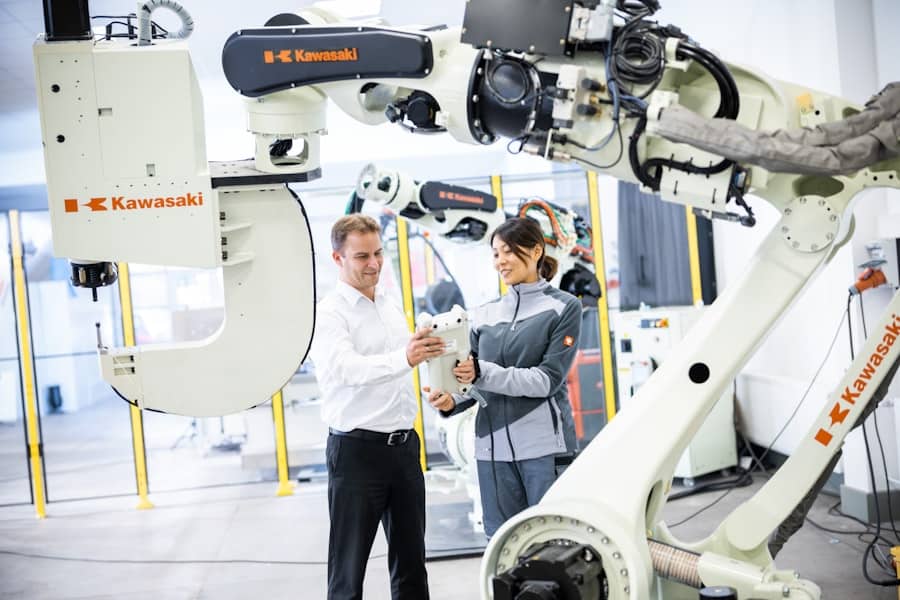The advent of industrial robots has revolutionized various sectors, particularly in the realm of micro-assembly processes. Micro-assembly refers to the intricate assembly of small components, often at a scale that is difficult for human hands to manage effectively. This field has gained prominence due to the increasing demand for miniaturized products across industries such as electronics, medical devices, and automotive manufacturing.
As products become smaller and more complex, the need for precision and efficiency in assembly processes has never been more critical. Industrial robots, with their ability to perform repetitive tasks with high accuracy, have emerged as indispensable tools in this domain. The integration of industrial robots into micro-assembly processes not only enhances productivity but also addresses the challenges posed by the miniaturization of components.
Traditional assembly methods often struggle to meet the stringent requirements for precision and speed, leading to higher rates of defects and increased production costs. In contrast, robots equipped with advanced sensors and vision systems can execute tasks with remarkable consistency, ensuring that even the tiniest components are assembled correctly. This shift towards automation is not merely a trend; it represents a fundamental change in how products are designed, manufactured, and brought to market.
Key Takeaways
- Industrial robots play a crucial role in micro-assembly processes by providing high precision and accuracy, which is essential for small-scale manufacturing.
- The use of industrial robots in micro-assembly processes offers advantages such as increased productivity, improved quality, and reduced labor costs.
- Different types of industrial robots, including SCARA, delta, and articulated robots, are commonly used for micro-assembly to meet specific requirements and tasks.
- Challenges in implementing industrial robots for micro-assembly, such as programming complexity and workspace limitations, can be overcome with advanced technologies and proper planning.
- Successful case studies demonstrate the effectiveness of industrial robots in micro-assembly, paving the way for future trends and innovations in this field.
The Role of Industrial Robots in Achieving Precision in Micro-Assembly
Precision is paramount in micro-assembly, where even the slightest deviation can lead to product failure. Industrial robots play a crucial role in achieving this level of accuracy through their sophisticated control systems and advanced programming capabilities. These robots can be programmed to perform tasks such as picking, placing, and aligning components with micron-level precision.
For instance, a robotic arm equipped with a high-resolution camera can identify the exact position of a component and adjust its movements accordingly, ensuring that each piece is placed with pinpoint accuracy. Moreover, the use of force feedback technology allows robots to sense the amount of pressure they are applying during assembly. This capability is particularly important when dealing with delicate components that could be damaged by excessive force.
By continuously monitoring and adjusting their actions based on real-time feedback, industrial robots can maintain the integrity of fragile parts while ensuring that they are securely assembled. This level of precision not only reduces the likelihood of defects but also enhances the overall quality of the final product.
Advantages of Using Industrial Robots for Micro-Assembly Processes
The advantages of employing industrial robots in micro-assembly processes are manifold.
Robots can operate continuously without fatigue, allowing for higher throughput compared to human workers.
This capability is especially beneficial in industries where time-to-market is critical. For example, in the electronics sector, where new products are frequently introduced, the ability to rapidly assemble components can provide a competitive edge. In addition to speed, industrial robots contribute to cost savings over time.
While the initial investment in robotic systems may be substantial, the long-term benefits often outweigh these costs. Robots reduce labor costs by minimizing the need for manual assembly, which can be both time-consuming and prone to errors. Furthermore, the enhanced precision offered by robots leads to lower scrap rates and reduced rework, further driving down production costs.
Companies that have adopted robotic solutions often report significant improvements in their return on investment (ROI), making automation an attractive option for businesses looking to optimize their operations.
Types of Industrial Robots Used for Micro-Assembly
Various types of industrial robots are employed in micro-assembly processes, each designed to meet specific needs and challenges. Articulated robots are among the most common types used in this field. These robots feature multiple joints that allow for a wide range of motion, making them ideal for complex assembly tasks that require flexibility and dexterity.
Their ability to reach into tight spaces and manipulate small components makes them particularly well-suited for micro-assembly applications. Another type of robot gaining traction in micro-assembly is the collaborative robot, or cobot. Unlike traditional industrial robots that operate in isolation, cobots are designed to work alongside human operators safely.
This collaborative approach allows for a more flexible assembly process where humans and robots can share tasks based on their respective strengths. For instance, a human worker might handle intricate tasks requiring fine motor skills while a cobot manages repetitive actions such as component placement. This synergy not only enhances productivity but also fosters a safer working environment.
Challenges and Solutions in Implementing Industrial Robots for Micro-Assembly
Despite the numerous advantages of using industrial robots in micro-assembly processes, several challenges must be addressed during implementation. One significant hurdle is the complexity of programming and integrating robotic systems into existing workflows. Many companies may lack the expertise required to effectively program robots for specific tasks or to integrate them seamlessly into their production lines.
To overcome these challenges, companies can invest in training programs for their workforce or collaborate with robotics experts who can provide guidance on best practices for implementation. Additionally, advancements in user-friendly programming interfaces and simulation software have made it easier for operators to design and test robotic tasks without extensive coding knowledge.
By leveraging these tools, organizations can streamline the integration process and maximize the benefits of robotic automation. Another challenge lies in ensuring that robots can handle the variability inherent in micro-assembly processes. Components may differ slightly due to manufacturing tolerances or environmental factors, which can complicate assembly tasks.
To address this issue, many companies are turning to machine learning algorithms that enable robots to adapt their actions based on real-time data. By continuously learning from their experiences, robots can improve their performance over time and better accommodate variations in component size or shape.
Case Studies of Successful Micro-Assembly Processes Using Industrial Robots
Numerous case studies illustrate the successful application of industrial robots in micro-assembly processes across various industries. One notable example is found in the electronics sector, where a leading manufacturer of smartphones implemented robotic systems to assemble intricate circuit boards. By utilizing articulated robots equipped with advanced vision systems, the company was able to significantly reduce assembly time while maintaining high levels of precision.
The result was a marked increase in production capacity and a decrease in defects, ultimately leading to improved customer satisfaction. In the medical device industry, another case study highlights how a company specializing in surgical instruments adopted collaborative robots for micro-assembly tasks. The cobots worked alongside human operators to assemble delicate components used in minimally invasive surgeries.
This collaboration not only enhanced efficiency but also allowed human workers to focus on more complex tasks that required critical thinking and problem-solving skills. The integration of cobots resulted in faster production cycles and improved product quality, demonstrating the potential of robotics to transform traditional manufacturing practices.
Future Trends and Innovations in Industrial Robots for Micro-Assembly
As technology continues to advance, several trends are emerging that will shape the future of industrial robots in micro-assembly processes. One significant trend is the increasing use of artificial intelligence (AI) and machine learning algorithms within robotic systems. These technologies enable robots to analyze vast amounts of data from their operations, allowing them to optimize their performance continuously.
For instance, AI-driven robots can predict potential issues before they arise, reducing downtime and enhancing overall efficiency. Another promising innovation is the development of soft robotics, which focuses on creating flexible and adaptable robotic systems capable of handling delicate components without causing damage. Soft robots utilize materials that mimic biological structures, allowing them to grasp and manipulate fragile items with care.
This technology holds great potential for industries where precision and gentleness are paramount, such as medical device manufacturing or electronics assembly. Additionally, advancements in sensor technology will further enhance the capabilities of industrial robots in micro-assembly processes. High-resolution cameras and advanced tactile sensors will enable robots to perceive their environment more accurately and make real-time adjustments during assembly tasks.
This increased sensory feedback will lead to even greater precision and adaptability, allowing robots to tackle increasingly complex assembly challenges.
The Impact of Industrial Robots on the Future of Micro-Assembly
The integration of industrial robots into micro-assembly processes marks a significant turning point in manufacturing practices across various industries. By enhancing precision, increasing efficiency, and reducing costs, these robotic systems have transformed how products are assembled at a microscopic scale. As technology continues to evolve, we can expect further innovations that will expand the capabilities of industrial robots even further.
The impact of industrial robots on micro-assembly processes extends beyond mere productivity gains; it also fosters a new era of collaboration between humans and machines. As companies embrace automation while recognizing the unique strengths of human workers, they create more dynamic and efficient production environments. The future promises exciting developments that will continue to shape the landscape of manufacturing, making industrial robots an integral part of micro-assembly processes for years to come.
If you are interested in exploring the world of technology further, you may want to check out the article Unlock a New World of Possibilities with Samsung Galaxy Z Fold4. This article delves into the innovative features of the Samsung Galaxy Z Fold4 and how it can revolutionize the way we use smartphones. Just like how industrial robots are transforming micro-assembly processes, the Samsung Galaxy Z Fold4 is pushing the boundaries of what is possible in the world of mobile technology.
FAQs
What are industrial robots?
Industrial robots are programmable machines that are used to perform a variety of tasks in manufacturing and production processes. They are designed to automate repetitive and precise tasks, such as assembly, welding, painting, and packaging.
How do industrial robots enable precise micro-assembly processes?
Industrial robots enable precise micro-assembly processes by providing high levels of accuracy and repeatability. They are equipped with advanced sensors and control systems that allow them to handle small and delicate components with precision, ensuring that each assembly is completed with the utmost accuracy.
What are the benefits of using industrial robots for micro-assembly?
Using industrial robots for micro-assembly processes offers several benefits, including increased productivity, improved quality control, and reduced labor costs. Robots can work continuously without fatigue, leading to faster and more consistent assembly processes. Additionally, they can handle intricate tasks that may be challenging for human workers, leading to higher precision and fewer errors.
What types of industries use industrial robots for micro-assembly?
A wide range of industries utilize industrial robots for micro-assembly processes, including electronics, medical devices, automotive, aerospace, and consumer goods. These robots are particularly valuable in industries that require the assembly of small and intricate components, where precision and accuracy are critical.
What considerations should be taken into account when implementing industrial robots for micro-assembly?
When implementing industrial robots for micro-assembly processes, it is important to consider factors such as the size and weight of the components, the required level of precision, the speed of the assembly process, and the overall layout of the production line. Additionally, proper training and maintenance of the robots are essential to ensure optimal performance and safety.



